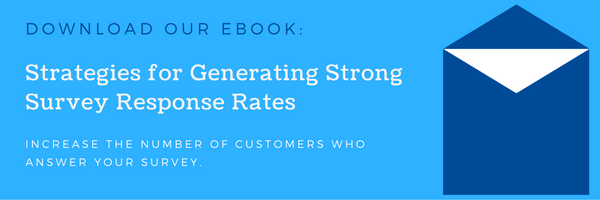A common challenge for many B2B companies is how to increase survey response rates for relationship surveys (those that are typically sent once or twice a year to gauge overall customer sentiment).
That’s because a small survey sample could render your survey data unreliable, or make it difficult to elicit meaningful insights to drive decision making. It’s also worrisome because you fail to capture how “silent” customers feel about your products, services, or people.
Suggestions for Increasing Survey Response Rates
Generating response rates that are above the B2B industry average is attainable. In fact, it’s something we regularly achieve for our clients.
What steps can you take to increase response rates for your relationship surveys? Here are some different tactics we suggest you try:
Highlight your upcoming B2B relationship survey early
Beyond informing existing customers of your survey efforts, Salespeople can also do their part by drumming up appreciation for future surveys when closing new deals.
And during the onboarding process, remind new customers that your company conducts formal feedback programs and acts on the input received. These actions help to lay a strong foundation that the customer’s voice will be heard.
Write your survey questions using best practices
This means offering appropriate scales and following a logical flow for your series of questions. And this might be obvious, but don’t ask questions you should know the answer to (i.e. “how long have you been our customer?”).
Make sure your survey isn’t too long; most customers are not willing to invest more than a few minutes to respond to a survey. Craft accurate subject lines that will drive people to open the survey.
Also, don’t frustrate respondents by not offering them the option to skip questions or answer with “NA”. More best practices can be found here.
Offer anonymity to survey respondents
Some customers fear damaging relationships with the people they work with closely. For this reason, your relationship surveys should be a “safe place” where everyone can feel free to speak their mind honestly.
We suggest that you include a question at the start of the survey that seeks permission to share the customer’s responses with those who are very close to the account.
Clean up your customer contact list
First, make sure you have a good quality contact list that includes the appropriate people (Decision Maker, Influencer, End User, etc.). Besides preventing “cherry-picking” positive responses to derive your score, a clearly defined contact list also enables you to look at loyalty levels across different customer groups.
Once your survey is launched, identify “bounces” (messages returned from inactive or non-existent email accounts) as they come in and correct them, if possible. You may need to designate people throughout the company to help provide better contact information for those bounced email addresses.
Think about survey timing
Your customer contacts are likely in different time zones. So consider staggering the times communications are sent to ensure they arrive in their inbox at the best times. You should also avoid sending surveys during the holidays or when customers are known to be busier than normal.
And because of possible vacations and travel days, give respondents at least two weeks to submit their responses.
Limit the number of surveys you send
Thanks to inexpensive survey tools and the singular goals within each department, customers can become inundated with requests for feedback. To avoid survey fatigue, work with your colleagues to determine the appropriate cadence.
A good rule of thumb: no more than 4 to 6 surveys (relationship surveys, onboarding surveys, product surveys, support surveys, etc.) per customer contact per year.
Let customers know their voices were heard
Closing the loop with customers is the greatest influencer for future response. So communicate with customers that your organization is reading survey responses and intends to implement meaningful changes. This can easily be accomplished with a post survey email.
For a more personalized approach (with detractors, for example), you can schedule a call to explore the feedback in more detail or go on-site to review the engagement and discuss improvement opportunities.
The Importance of High Response Rates
When it comes to researching how to increase survey response rates, it’s important to recognize there are many different actions you can take to encourage customer participation. And by implementing a few of these best practices, you increase the percentage of customers likely to respond and, therefore, the statistical validity of the data captured.


